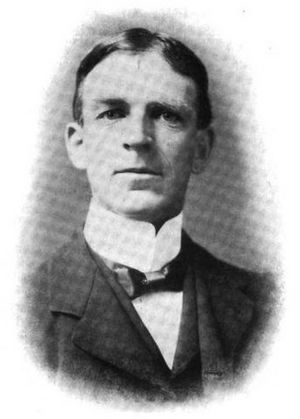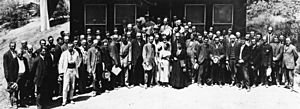William Wallace Campbell facts for kids
Quick facts for kids
William Wallace Campbell
|
|
|---|---|
 |
|
| Born | April 11, 1862 Hancock County, Ohio
|
| Died | June 14, 1938 (aged 76) San Francisco, California
|
| Alma mater | University of Michigan (B.S.) |
| Known for | Spectroscopy, University President |
| Spouse(s) | Elizabeth Ballard Thompson |
| Children | Wallace, Douglas, Kenneth |
| Awards | Lalande Medal, Gold Medal of the RAS, Draper Medal, Janssen Medal, Bruce Medal |
| Scientific career | |
| Fields | Astronomy |
| Institutions | University of California, Berkeley |
William Wallace Campbell (born April 11, 1862 – died June 14, 1938) was a famous American astronomer. He was the director of the Lick Observatory for many years, from 1901 to 1930. Campbell was an expert in spectroscopy, which is the study of how light interacts with matter. He also served as the tenth president of the University of California from 1923 to 1930.
Contents
Early Life and Education
William Wallace Campbell was born on a farm in Hancock County, Ohio. His parents were Robert Wilson and Harriet Welsh Campbell. After attending local schools for a few years, he went to the University of Michigan in 1882. He studied civil engineering and earned his Bachelor of Science degree in 1886. While at university, he became very interested in astronomy. This happened after he read a book called Popular Astronomy by Simon Newcomb.
A Career in Astronomy
After graduating, Campbell first worked as a Professor of Mathematics at the University of Colorado. But he soon returned to Michigan to teach astronomy. In 1891, he was invited to work on spectroscopy at Lick Observatory in California.
Campbell was a pioneer in astronomical spectroscopy. This means he was one of the first to use this method to study stars. He created a catalog of the "radial velocities" of stars. Radial velocity tells us how fast a star is moving towards or away from us. He was also known for his work in photographing solar eclipses. In 1893, he discovered a special type of star called a Wolf–Rayet star, known as HD 184738. He became the director of Lick Observatory in 1901 and held that position until 1930.

Testing Einstein's Theory
In August 1914, Campbell and Erwin Freundlich from the Berlin Observatory traveled to Russia. They wanted to photograph a solar eclipse. Their goal was to test Albert Einstein's general theory of relativity. This theory predicted that gravity could bend light.
However, World War I began, and Germany declared war on Russia. Freundlich and his equipment were seized by Russian officers. Campbell, being from neutral America, was allowed to continue. But clouds covered the eclipse, so he couldn't get the photos he needed.
Campbell tried again to photograph a solar eclipse on June 8, 1918, in Goldendale, Washington. His special photographic equipment was still in Russia. So, he had to use other equipment from the Lick Observatory. These cameras were not precise enough to confirm Einstein's theory. The equipment from Russia finally arrived back in America in August 1918.
Confirmation of Einstein's theory came in 1919. This was thanks to an expedition led by Arthur Eddington to photograph an eclipse. But some doubts remained. Final and clear confirmation came from Campbell's own expedition in 1922. He traveled to Australia to photograph a solar eclipse. Campbell reported that his observations "agree exactly with Einstein's prediction."
Leadership Roles
Besides his work at the observatory, Campbell was also a leader in education. He served as the 10th President of the University of California from 1923 to 1930. He was also on the board of trustees for Science Service (now Society for Science & the Public) from 1923 to 1926. He served three times as president of the Astronomical Society of the Pacific (in 1895, 1909, and 1918).
In his later years, Campbell faced some health challenges. He married Elizabeth Ballard Thompson in 1892. They had three sons, including Douglas Campbell, who was a World War I flying ace.
Honors and Awards
William Wallace Campbell received many awards for his important work:
- Lalande Medal from the French Academy of Sciences (1903)
- Henry Draper Medal from the National Academy of Sciences (1906)
- Gold Medal of the Royal Astronomical Society (1906)
- Janssen Medal (1910)
- Bruce Medal (1915)
- Foreign Member of the Royal Society of London (1918)
- Honorary Fellow of the Royal Society of Edinburgh (1920)
- Trustee of the Carnegie Institution (1929–1938)
Places and objects named after him:
- Crater Campbell on the Moon
- A crater on Mars
- Asteroid 2751 Campbell
- Campbell Hall on the University of California, Berkeley campus
Crocker Expeditions for Solar Eclipses
Charles Frederick Crocker and William Henry Crocker helped fund many Lick-Crocker solar eclipse expeditions. Campbell led several of these important trips to study eclipses:
- Solar eclipse of January 22, 1898, in Jeur, Maharashtra, India
- Solar eclipse of May 28, 1900, in Thomaston, Georgia
- Solar eclipse of August 30, 1905, in Alhama, Spain
- Solar eclipse of January 3, 1908, in Flint Island, Kiribati
- Solar eclipse of August 21, 1914, in Brovary, Ukraine
- Solar eclipse of June 8, 1918, in Goldendale, Washington
- Solar eclipse of September 21, 1922, in Wallal, Australia
Family Life and Contributions
William Wallace Campbell married Elizabeth Ballard Thompson in 1892. They had three sons. One of their sons was Douglas Campbell, a famous pilot during World War I.
Elizabeth played a very important role in Campbell's success as a scientist. She helped him greatly with his work. As the director's wife at the Lick Observatory, she often hosted guests. She also helped with public relations for the Observatory. She wrote letters to staff and people who might donate money to support her husband's research.
Elizabeth also organized many of the expeditions that Campbell led. She arranged travel, food, supplies, and places for the expedition members to live. She even helped with the scientific work. She did astronomical spectroscopy, developed photographic plates, and wrote detailed notes about the expeditions. She even wrote two manuscripts about their adventures.
See also
 In Spanish: William Wallace Campbell para niños
In Spanish: William Wallace Campbell para niños

